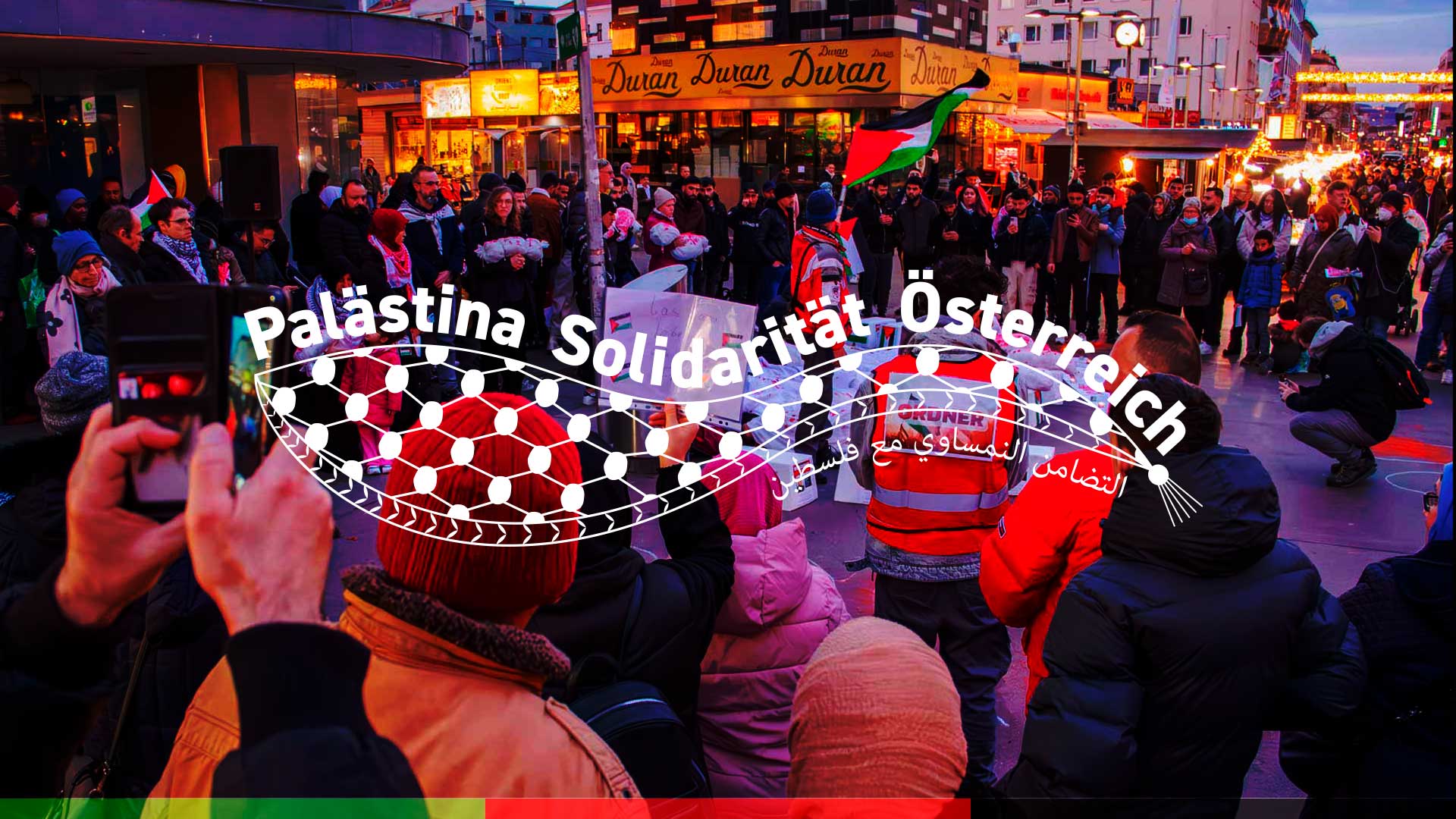Israels Siedlungsbau=Landraub
Samstag, 3.4.2010, 14 bis 16 Uhr
Graben / Ecke Tuchlauben
1010 Wien
Israels Siedlungsbau=Landraub
Samstag, 3.4.2010, 14 bis 16 Uhr
Graben / Ecke Tuchlauben
1010 Wien
Israeli Settlements in the occupied territories: The facts
A Brief Background
· In 1947, the UN partitioned Palestine (whose population was 70% Palestinian Arab) and decreed that 55% of the land would be used to create Israel
· In 1948, Zionist forces seized more land, razing about 500 Palestinian villages to the ground and driving 750,000 Palestinians abroad as refugees. More than 13,000 Palestinians were killed
· Zionist forces now occupied 78% of the land, and the state of Israel was declared. The UN recognised the remaining 22% – divided between the West Bank and Gaza – as Palestinian territory
· In 1967, Israeli forces invaded and occupied the West Bank, Gaza and the Golan Heights, which belong to Syria, and still remain there today
· UN Resolution 242 calls for Israel to withdraw from the territory it occupied in 1967, rendering its occupation of the West Bank (including East Jerusalem), Gaza and the Golan Heights illegal under international law
What is an Israeli settlement?
· Israel began building settlements on Palestinian land in the West Bank immediately after its occupation in 1967
· The settlements are built strategically on hilltops, so they dominate the landscape, and are surrounded by high walls
· A settlement can consist of a few Israeli military huts or be a large town, complete with shopping malls, leisure centres, and luxury homes with swimming pools
· Settlement farms and industrial zones steal more Palestinian land
· Israelis are encouraged to move to the settlements through tax breaks given by the Israeli government. In the United States, glossy advertising campaigns promise ‘fresh mountain air‘, ‘stunning views‘ and ‘wide open spaces‘ to those wishing to buy a settlement property and emigrate. Palestinians are not allowed to live in the settlements built on their land
· There are now 200 Israeli settlements in the West Bank, all built in contravention of international law, and they house approximately 450,000 Israeli settlers
· Roads have been built to connect the settlements to Israel, thus cementing their place in the West Bank. More Palestinian land is stolen to build the roads, which often cut villages in half. Palestinians are not allowed access to the roads
The Settlements and International Law
· UN Resolution 446 states that the settlements have ‘no legal validity, and constitute a serious obstruction to achieving a comprehensive, just and lasting peace in the Middle East‘
· In 2004, the International Court of Justice concluded that the settlements ‘have been established in breach of international law‘
· UN Resolution 465 declares that ‘Israel’s policy and practices of settling parts of its population and new immigrants in those territories constitute a flagrant violation of the Fourth Geneva Convention‘
The Impact of the Settlements on Palestinian Life
· Palestinian villages, olive groves and farms have been stolen and demolished to build the settlements, leaving many Palestinians homeless and without a means of supporting themselves and their families
· Settlers act largely with impunity in disrupting Palestinian life, often violently. Road blocks are set up, cars burned, windows smashed and crops burned. Palestinian farmers are shot at as they attempt to harvest their crops, and children attacked on their way to and from school. Israeli security forces do not protect the Palestinians and almost never enforce the law against settlers
· While the settlers, as citizens of Israel, enjoy full civil rights, Palestinians – living under occupation – are subjected to military law
· As the settlements have eaten up an increasing amount of their land, the Palestinians of the West Bank have been reduced to living in enclaves, separated from each other and surrounded by the Apartheid Wall, with their movement controlled and severely restricted by hundreds of Israeli checkpoints
· As a result, education has virtually ground to a halt, basic healthcare services are dangerously inadequate, and the economy has been devastated
Water and the Settlements
· Each settler is allocated 1,450 cubic metres of water a year by the Israeli government. Each Palestinian in the West Bank is given 83 cubic metres a year
· Settlements are built near, and control, vital water sources
· Many of the settlements are built in the fertile Jordan Valley area of the West Bank, and settlers living here are provided with free water for irrigation. Much of the Israeli agricultural produce in UK shops is from this area
· In some rural communities, Palestinians survive on barely 20 litres of water a day, the minimum amount recommended for domestic use in emergency situations
Palestinian Workers in the Settlements
· The destruction of the West Bank’s economy and the expropriation of farmland to build settlements has forced many Palestinians to seek work in settlement farms and industrial zones
· They earn less than 50% of the Israeli minimum wage and sometimes as little as five US cents an hour
· They receive no holiday pay, pensions or sick pay and work in unprotected conditions in all weathers
· If they are injured at work, they do not receive compensation
· Palestinians require permits to work, which are removed if they complain about their pay or conditions. The Israeli settlers do not require work permits
· Palestinian trade unions are not recognised in the Israeli settlements, and Palestinians are not allowed to join Israeli trade unions
Source: Palestine Solidarity Campaign
Frauen in Schwarz (Wien) www.womeninblack.at







